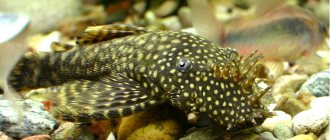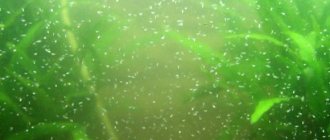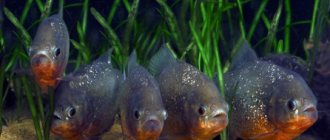The decision of which fish to get first in your aquarium can be sudden, or it can be deliberate. Unfortunately, novice aquarists are often guided by the first impulse, without understanding fish at all.
And then, instead of joy and pleasure, they get headaches and problems. You need to choose fish wisely, because their life and your comfort depend on your choice. Before you go to the store or market, study all the available information about the fish you like.
We looked at what fish beginners should not buy here. And the top 10 unusual fish are here.
And to make it easier for you to navigate, we have compiled a list of unpretentious aquarium fish for beginners and briefly described them. All of them are distinguished by their unpretentiousness, tolerance to conditions in the aquarium, peaceful nature, easy-going nature and modest size. We hope it will help make your choice easier!
Guppies and Endler's guppies
A classic for any beginner in aquarium keeping - guppies. They are very unpretentious, easy-going, and easy to get along with.
It is very easy to distinguish males from females; males have a large tail, they are much brighter, and their anal fin is elongated. Females are larger, fuller and have a shorter anal fin, and most importantly, they are gray, only the caudal fin is colored.
They are viviparous, which means the fry immediately swim and are adapted to life. At one time, a female guppy can spawn from 10 to 60 fry. But if you leave the fry in a common aquarium, they will quickly eat it; you need to catch the fry in a separate container.
Breeding them is very simple, just keep males and females together.
Guppies eat all types of food and can grow well on branded food - flakes, granules, etc.
It is worth noting that beginners are not recommended to have purebred forms of guppies; due to the long mixing of blood, they, on the contrary, have become capricious and difficult to maintain.
There is also a species of Endler guppies. The differences between Endlers are that they themselves are much smaller, the males are not veiled, they are much more nimble, fewer fry are born at a time, but the fry themselves are larger and they breed more often.
Swordtails/mollies/platies/
Let's combine them into one group (swordtails/mollies/platies/), since they are very similar in behavior and content, although they are very different in appearance. Just like guppies, they are viviparous. This means there will be no problems with the fry, it immediately swims, eats, and hides.
They are very easy to breed, the principle is the same as for guppies - just keep males and females together. They are very bright and active fish, you will not need to look for them to look at them, on the contrary, they will always beg you for food.
They tolerate different conditions in the aquarium and forgive mistakes that beginners often make.
They eat all types of live, artificial, frozen food. In general, they are similar to guppies in content, but they are larger in appearance and have a variety of colors and body shapes. As a word of caution - do not buy many male swordtails in one aquarium, they can fight!
Neon Tetras
Neon Tetra (CC BY-SA 4.0)
The neon tetra has rightfully earned its name due to the vibrant colors it displays. You can get this fish in blue, red and translucent colors. This is one of the most basic fish and is quite popular among novice fish owners.
Like most of the previous species, the neon tetra is also very peaceful and likes to live in small groups. If you care for them properly, they can live up to 8 years. But they won't get too big. The normal size of a tetra is about 1.5 inches.
To make the aquarium best suited for your tetras, be sure to include plenty of plants. This is what their natural environment looks like.
Additionally, a 10-gallon tank is the minimum for this breed, especially if you plan to introduce other species.
The water temperature should be maintained between 70 and 81 degrees Fahrenheit.
Danio rerio
Danio rerio is a small (up to 5-6 cm), graceful fish. Due to its small size, peaceful disposition and unpretentiousness, it has earned great popularity in the aquarium hobby.
Since this is a schooling fish, it is better to keep at least 5-6 individuals. The aquarium can be planted with plants, but it is important that the zebrafish have free space to swim near the surface, as it is a very active fish.
If you are going to get a veil form, do not plant them with fish that can break off their fins, for example, the Sumatran barb. The aquarium must be closed as the danios may jump out of the water.
Omnivores, they eat any type of food - artificial, live, frozen. It is better to feed them flakes, as they pick up food from the surface of the water and happily collect flakes that do not sink for a long time. Breeding zebrafish is very easy; the female lays from 200 to 500 eggs at a time.
General requirements
Due to the tiny volume of the container, not all aquarium inhabitants are suitable for you.
Therefore, you should pay attention to the following criteria:
- Small size. Acceptable body length is 2-6 cm.
- Calm, peaceful character. A lonely fish will certainly get bored, its color will fade, which is why it is recommended to keep aquatic inhabitants in schools, even in small containers.
- Unpretentiousness. It is not easy to create ideal conditions in a 10-liter container, so exotic varieties with a whole list of necessary maintenance rules will not work. It is advisable to choose hybrids; they have stronger immunity.
- Bright color. The criterion is not as important as those previously indicated, but the beautiful colors and shades of scaly bodies will help create an amazing mini-composition, a true work of art.
Cardinals
This is a very small (2.5-3 cm) and very unpretentious fish. At the same time, it is brightly colored, easy to breed and completely non-aggressive; cardinals do not even touch their fry.
They tolerate cold water well, some even keep them in a pond in the yard in the summer. They like to move in the middle layers, and also like to gather in flocks. You need to keep them in small flocks, from 6 pieces. Although they can be large, given their modest size, cardinals do not require large aquariums. With good maintenance they can live up to 3 years.
Corridors
These are small, agile, beautiful and schooling catfish. There are many different species of corydoras, but the most popular are the speckled catfish and the golden catfish.
They are all similar in their behavior - living on the bottom, they are constantly looking for leftover food, thereby cleaning the aquarium. They are very mobile, while remaining quite small, and tolerate a wide range of conditions.
Any type of food is suitable for feeding, but it is important to ensure that the food falls to the bottom, and the catfish do not remain hungry while other fish fill their bellies.
It is best to feed corydoras with special food for catfish; they sink quickly, and when they fall to the bottom they do not fall into pieces. It is better to keep Corydoras in a flock; they love to live surrounded by relatives, and it is very interesting to watch them in a flock.
Wedge-spotted rasboras
A very beautiful and very small fish, which is a perfect companion for all of the above fish. They grow up to 5 cm and are very peaceful.
Its beautiful coloration with a black spot (for which it got its name), small size and peaceful disposition have made it very popular.
It is better to keep cuneiform rasboras in a school, and there should be enough free space in the aquarium for swimming.
A flock of rasboras stay together and are a great addition to any aquarium. You can feed her with a variety of foods, but it’s important not to give her large ones, as she simply won’t be able to swallow them.
Origin
“Domestic” fish first appeared in China around the 13th-14th centuries. It was during this period that goldfish began to be bred in the monastery ponds, which gradually changed, acquiring a bright color, but a smaller size.
At the beginning of the 16th century, the idea of populating artificial reservoirs spread in Korea, then in Japan. The Japanese made a special contribution to the development of species - they created new varieties that differed in both size and color. Nowadays, the inhabitants of aquariums differ in shape and color; among them there are owners of bright scales that glow in the dark. Some lovers of the aquatic world prefer to observe the bizarre behavior of real giants. And other aquarists opt for small biotopes.
Acantophthalmus
This is one of the most unusual fish that even an inexperienced aquarist can spot.
Belonging to the loaches, it somewhat resembles a small snake. But at the same time it is completely harmless and quite hardy. Acantophthalmus often hides during the day, and in order for it to feel comfortable, it needs shelter and soft soil in which it likes to dig.
In soft soil, he is able to find and dig up buried bloodworms, not to mention other food.
If there is sand in the aquarium, he will happily bury himself in it. This means it helps keep the aquarium clean by eating everything that falls to the bottom. You can feed it with any sinking food, but additionally add catfish food, preferably at night.
It can escape from the aquarium, it needs to be covered. Readers said that it can dig up stones in the sand, but I’ve never encountered anything like this, mine definitely didn’t dig up anything.
Definition
A small aquarium is considered to be one with a volume of no more than 50 liters and a length of 20-40 cm.
Nanoaquarium is a container with a capacity from 5 liters to 20 liters. You shouldn’t think that its tiny size makes it easier to care for; in fact, keeping such a “crumb” clean and tidy is much more difficult than dealing with a traditional format. The advantages include affordable cost and the ability to install in a small room. Most often the models are cubic or rectangular.
A small amount of water inevitably leads to a serious problem - even the most minor changes immediately affect the health of its inhabitants.
Equipment and arrangement
A small tank should be prepared for the settlement of aquatic inhabitants no worse than its large “brother”.
Before purchasing fry, make sure you have:
- LED lamp that does not heat the water;
- filter of sufficient power;
- compressor;
- heater (preferably with a thermostat);
- plants that are suitable in size, for example, dwarf anubias;
- decor
Beginners may want to consider a fully stocked aquarium that comes with everything they need already installed (such as the Dennerle Nano Cube).
Important! The filter is especially important for a small tank, where any change in equilibrium can lead to the death of all inhabitants. It must pass at least 8 liters of water per hour, have a large filler surface and have water intakes that prevent unwary fish from getting into.
Cockerels or marbled gourami
The fish belong to the same genus - labyrinth fish. These fish live in oxygen-poor water and have adapted to this by learning to breathe oxygen from the surface. You will see how they rise to it to take another breath of air.
Small, peaceful, males are very brightly colored, and their pelvic fins have turned into long processes. You can feed any food, including floating food. Only give bloodworms with caution and in small quantities; cockerels do not digest it well.
In general, the betta is one of the most popular and unpretentious aquarium fish. He is beautiful, he does not need a lot of space to keep him, he eats little. But there are also disadvantages; it’s not for nothing that bettas are called fighting fish. Two males in an aquarium will result in one killing the other.
I agree, and will add that there is another wonderful fish from the same genus - gourami. There are many types, but for beginners a good choice is the marbled gourami. Very hardy, peaceful, unusual shape and color.
It is generally similar to a cockerel, but larger and less demanding. So you can stop at this magnificent fish, and get a betta a little later.
Labyrinthine
Representatives of the Labyrinthids are unpretentious aquarium fish for beginning aquarists. The peculiarity of these phenotypes is the structure of the respiratory organs, so they do not need additional aeration of the aquarium. To provide air for pets, leave an empty space between the lid and the water surface so that the fish can breathe.
The disadvantage of labyrinth fish is their aggressive nature. Representatives are considered territorial phenotypes, and often fight with males and attack small and weak neighbors.
Among labyrinth aquarium fish, the most unpretentious are macropod fish and bettas.
Macropod
Representatives of the species reach up to 10 cm in length. Despite the restiveness and fury of macropods, fish are caring parents. In addition, macropods are beautiful - their scales shimmer in the light, which is why macropods are called “paradise fish”.
Macropod
Bettas
The name of the fish reflects their character. Cockerels, despite their attractiveness, get into fights with their relatives, fighting for territory and females. They reach a length of 6 cm. When keeping cockerels, you should only take care of the cleanliness of the water, the rest is unimportant for the fish. It is also important to familiarize yourself in advance with how to treat betta fish.
Bettas
Cherry barb
A peaceful, small fish, the males of which are very brightly colored, for which they got their name. This is a schooling fish, so it is better to keep at least 5 cherry barbs.
But you will notice that he does not stay tightly, gathering in a flock only when frightened. The cherry barb is small in size, the color of the males is bright red and very noticeable, and the maintenance requirements are low. This is a good fish to include on our list.
How to choose unpretentious fish for an aquarium?
When choosing unpretentious aquarium fish, you need to consider the following characteristics.
Table. How to choose an unpretentious aquarium fish?
| Name | Short description |
| Temperament compatibility | You need to know about the habits of this or that species so that there are no conflicts in the future. |
| Eating habits | The inhabitants of the aquarium feed at different levels - some get food from the bottom, others feed near the surface. If you don’t think through the nutritional system, it will have a bad effect on the health of the fish. |
| Conditions of detention | Also, for proper settlement it is necessary to take into account the requirements for the habitat. In particular, you need to consider water hardness , acidity level and comfortable temperature. |
| Pack keeping | Most small fish live in schools in natural conditions. To keep your pets in good health, introduce several pets. |
| Adult size | If you clearly know what size an adult fish will reach, you can avoid making a common mistake. |
Ancistrus
This is perhaps the largest fish on the list; it grows about 15 cm, if the aquarium allows. But it has earned its popularity for its unusual appearance, for the fact that it cleans the aquarium and for its endurance. Ancistrus is a catfish, but it is an unusual catfish; in nature it lives by eating algae and fouling.
And his mouth turned into a suction cup, with which he scrapes it all off. In the aquarium, he is a cleaner of walls and decor.
Males have unusual growths on their heads that make them very distinctive. Peaceful, but can get into fights with other males. Vegetable nutrition is important for him; he needs to be fed with special tablets.
Adviсe
- Understand the issue. A little time to study and you more or less understand what you need. This means you won’t get disappointment instead of joy.
- Do not take many fish or different species at once. Different sizes, behavior and volume requirements will immediately create compote in your aquarium. The most common sight at pet markets is a child with a bag in which incompatible fish are swimming. Will such a package bring a lot of joy to a child?
- Don't trust sellers. They need to sell. Not that they are such cynics, but when you sell fish, there is not much choice. Kids are good clients. So are the green novices.
- It's better to take one type of fish to start with.
- And it’s better if they are viviparous. They definitely won’t die in a week (unless you try really hard), they are bright, alive and even breed on their own.
- Take the first fish - guppies. Seriously. Yes, they are not cool, but they... (described above).
- Don't take goldfish. Seriously. They are unpretentious and quite hardy, but they eat a lot, shit just as much and need spacious aquariums. And they don't grow small.
- Don’t immediately buy everything you think you need for your aquarium. The list could be endless, but off the top of my head: light, filter, net, water conditioners, plastic plants, live plants, food, glass scraper, plastic shipwreck or worse, skull, bright soil.
- But what you really need from all this is: a net, food, a filter. Most fish don’t care about plants, soil, or light. They live well without them.
- Prepare the water. Ideally, buy a water conditioner and fill it up; it’s not expensive and will last a long time. You do not want? Just let it heat up and settle.
- Do not release the fish immediately. Place the bag in the water and let it float. Open it and add a little water from the aquarium. Repeat after a while.
- There are two guaranteed quick ways to kill your fish: underfeeding and overfeeding. If everything is clear with the first, then the second seems not obvious. Advice: take food away from grandparents and children. They feel sorry for the fish, the fish are asking for food. Fishes are stupid, unfortunately, and ask constantly. Only the food is not eaten, it rots, and the rotting products kill the fish themselves.
- Feed the fish yourself. Twice a day. Why two? And the fish are always full and the food does not go to waste and the portion is moderate.
- Change the water. Once a week. Yes, once, yes every time. 20-25% will be fine. Yes, even in a 5 liter aquarium. Try closing the windows, not flushing the toilet, and live like this for a month. Fish feel about the same way.
- Make beautiful designs. Keep difficult fish. Separate them. Enjoy your hobby, your life. Make your life interesting.











